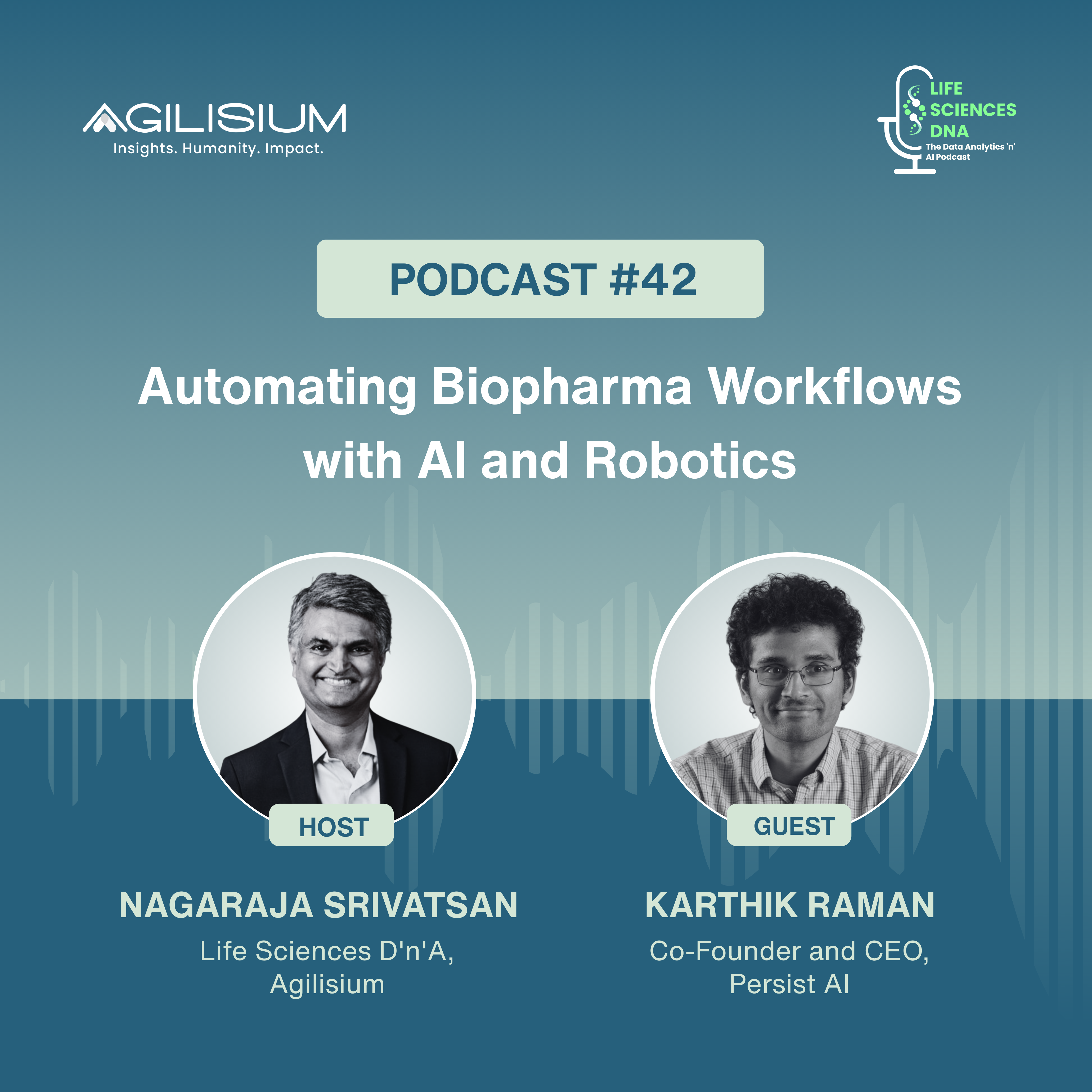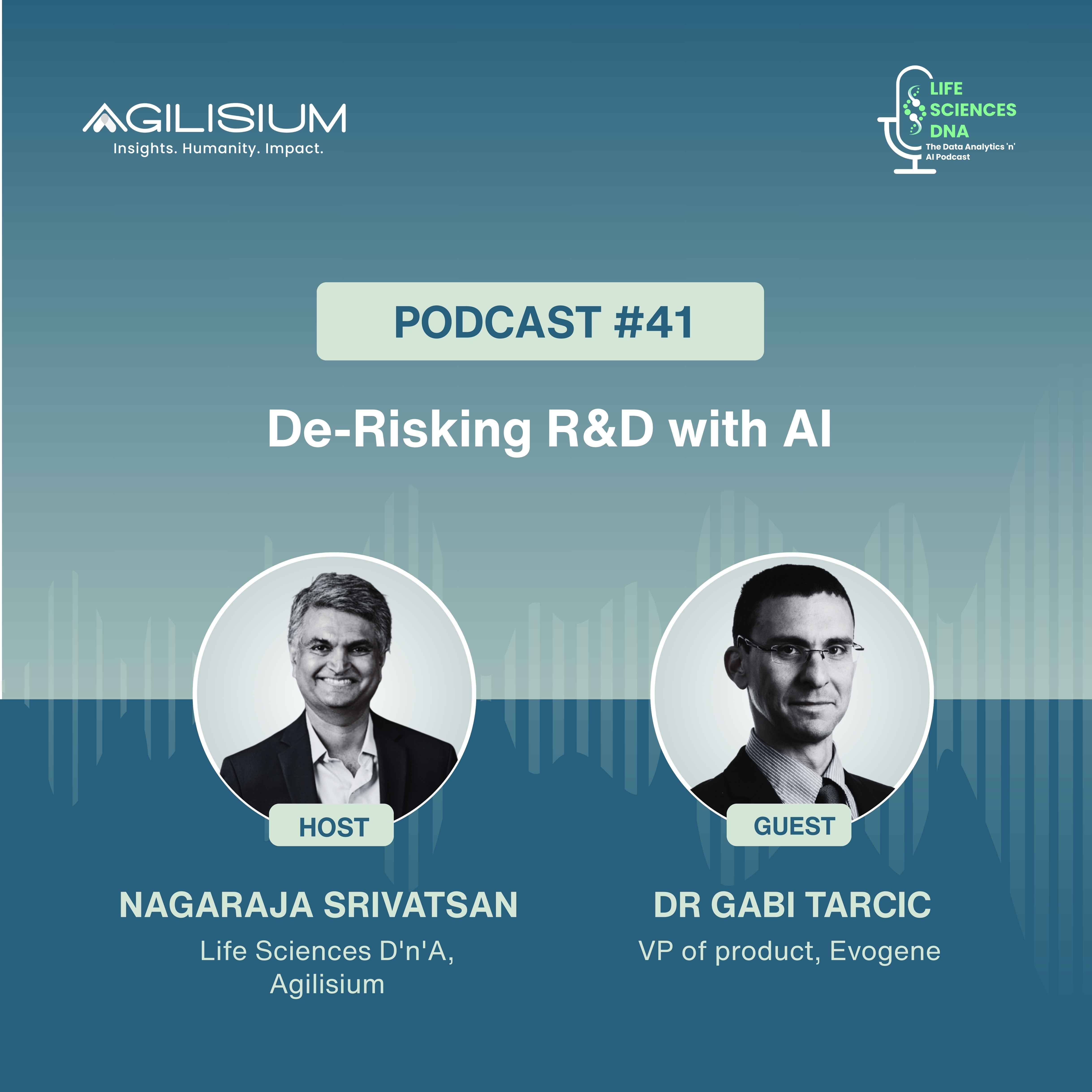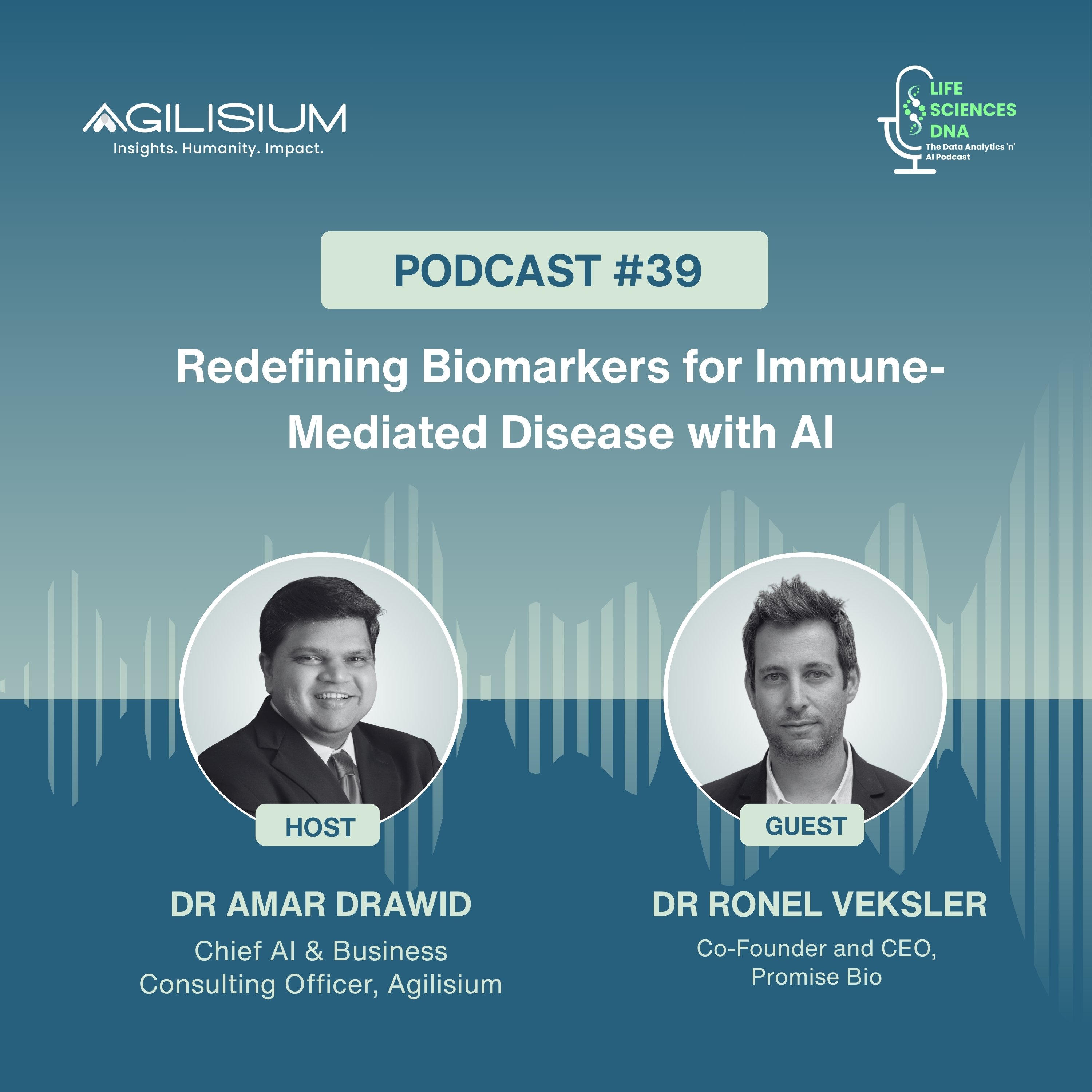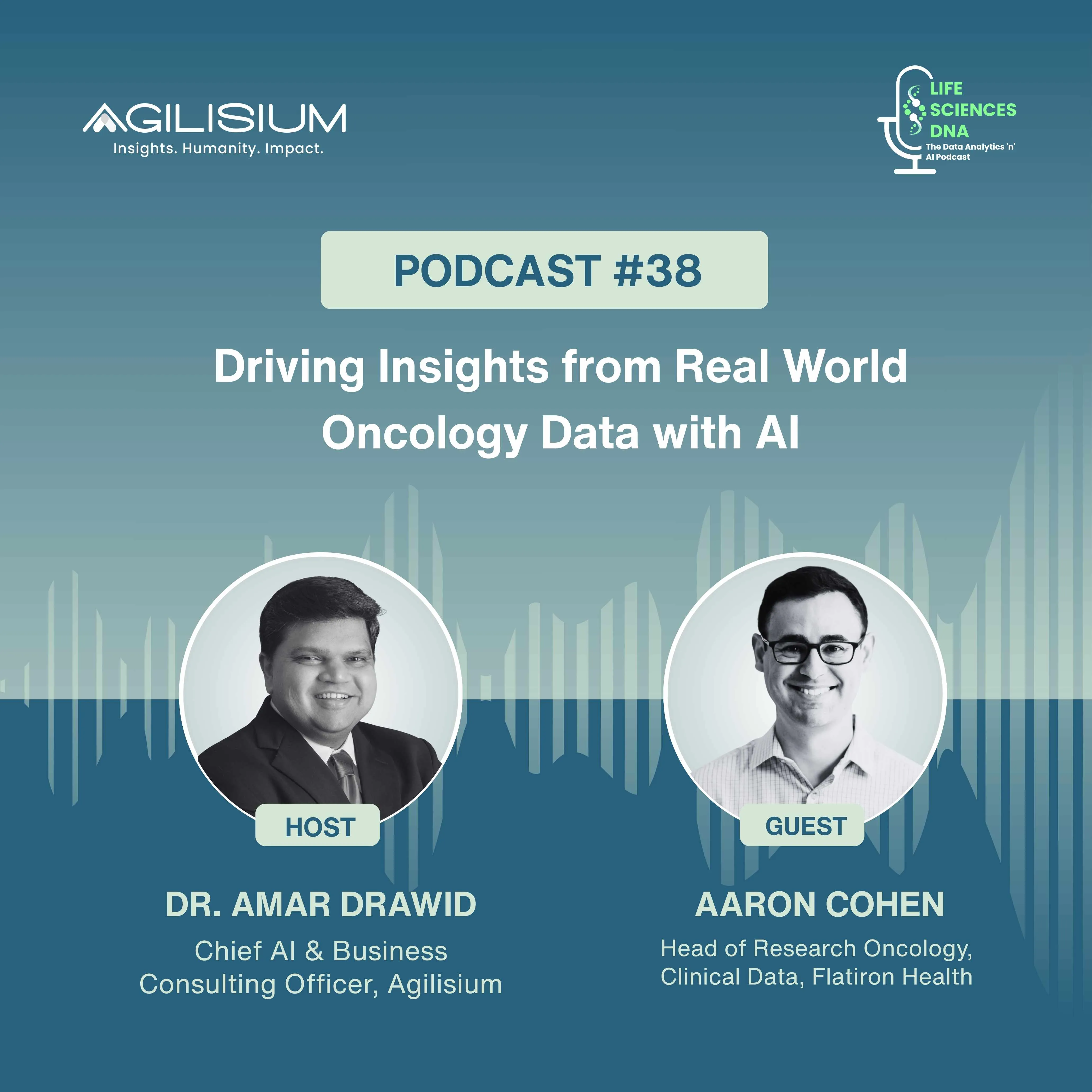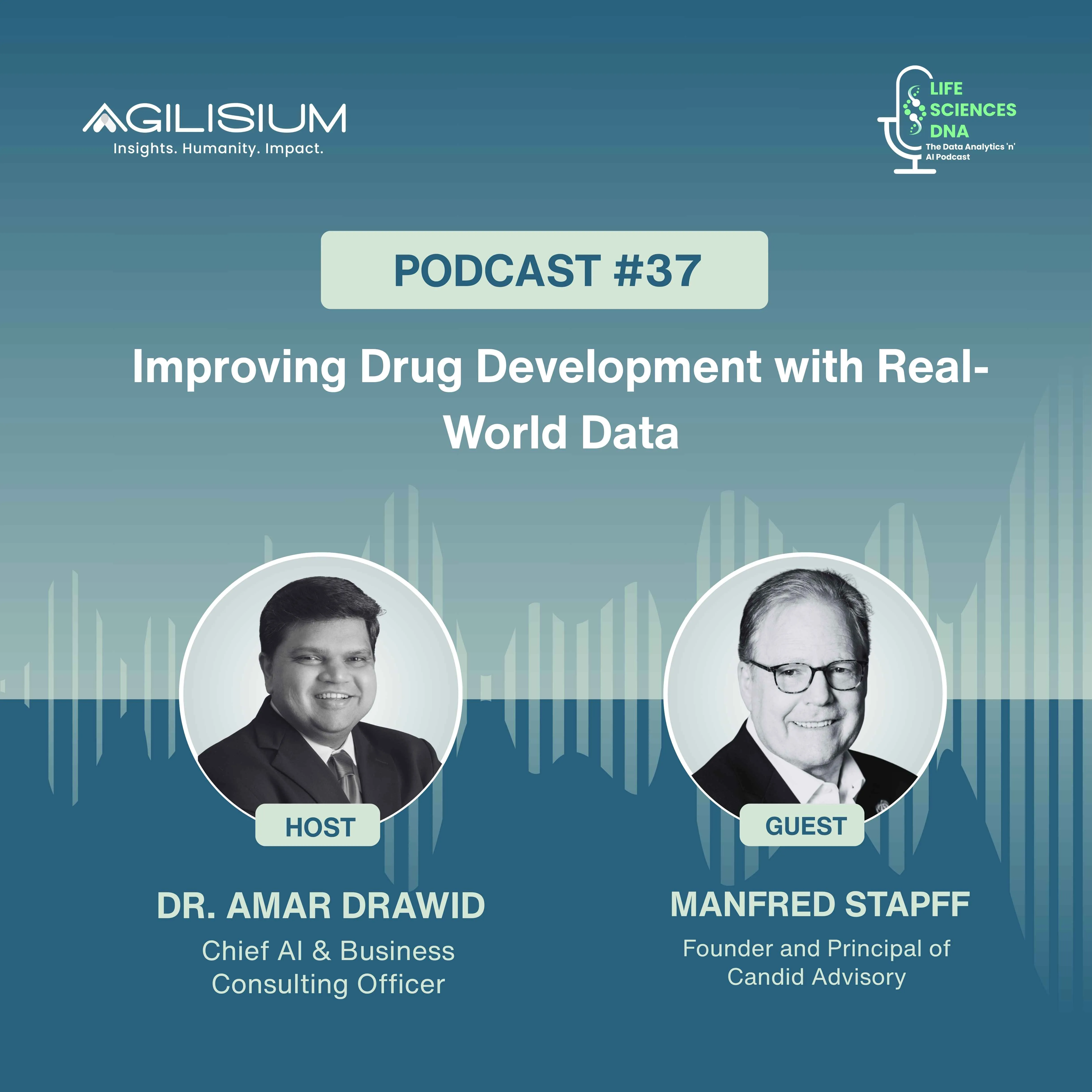Transforming Clinical Development with AI
In This Episode
This episode of the Life Sciences DNA Podcast brings to light how AI is becoming a game-changer in clinical development. It’s not about replacing the human touch—it's about giving trial teams the intelligence and tools to move faster, smarter, and with greater confidence.
- Walk through of how AI touches every stage—from protocol design and patient selection to trial monitoring and reporting.
- Explaining how AI helps identify the right patients at the right time—speeding up recruitment and improving trial fit.
- Sharing how trial leaders are using AI to forecast issues, adjust operations early, and stay ahead of delays.
- Illustration of how AI pulls together fragmented data sources—giving trial teams a clear, connected view of performance.
- Tying it all back to what really matters—more efficient submissions, stronger data, and faster access to life-changing therapies.
Transcript
The Life Sciences DNA podcast is sponsored by Agilisium Labs, a collaborative space where Agilisium works with its clients to co-develop and incubate POCs, products, and solutions. To learn how Agilisium Labs can use the power of its generative AI for life sciences analytics, visit them at labs.agilisium.com.
Daniel Levine (00:26.198)
Sri, who do we have on the show today?
Nagaraja Srivatsan:
Danny, today we have Bhaskar Sambasivan. Bhaskar is currently the CEO of Saama. Prior to that, he was the CEO of Citiastec, a technology and services company. And before that, he was chief strategy officer and president of patient services at Eversana. I have known Bhaskar from his days at Cognizant when he was the global life sciences leader for nearly 15 years. We're really excited to have Bhaskar on the show today.
Daniel Levine:
What are you hoping to hear from Bhasker today?
Nagarajan Srivatsan:
Bhaskar is an expert in all aspects of life sciences, and I'm really looking forward to hearing from him on how AI and its implementation in clinical research can drive tangible and better results in the marketplace.
Daniel Levine:
Before we begin, want to remind our audience that they can stay up on the latest episodes of Life Sciences D'N'A by hitting the subscribe button. If you enjoy this content, be sure to hit the like button and let us know your thoughts in the comments section. With that, let's welcome Bhaskar to the show.
Nagaraja Srivatsan: (01:45.794)
Bhaskar, today we want to explore topics about AI in clinical development. You've been in the industry for quite some time. Can you share with us what you think are practical applications of AI in clinical development?
Bhaskar Sambasivan:
Sri, there's a lot of obligation of AI in clinical development, but both from an industry standpoint as well as what we are trying to do at Saama, specifically through our platform, is we are focusing a lot of AI across the clinical continuum. And when we start thinking about specific process areas, it ranges all the way from startup to data management, to biometrics, medical writing, and also project management. Essentially, if you were to think about the most amount of efforts that are expended in a clinical study, it's about 60% of the effort that can actually be impacted in a positive way for improving time, cost, and effort optimization, almost 60%, which could be specifically if you have to drill down its data review, data cleaning, getting to a database lock in the biometric side, a generation of SDTM, ADMS, TLS, and even document generations like protocols, patient narratives, so on and so forth. So that's our big focus area as we think about the application of AI within clinical development.
Nagaraja Srivatsan:
Bhaskar, those are some really great use cases, and I really like how you started the full continuum of clinical development. Why don't we peel that area by area and why don't we explore a bit some tangible use cases on what do you think are what happened before AI and what are some of the AI applications in those areas? Let's start with just study startup. You talked about it. Study startup is a great area. Then followed by data management. Maybe we can look at those early setup areas of clinical trials. And let's start to explore what do you think was the past on how work was done? And then how does AI get you to that 60 % improvement in productivity?
Bhaskar Sambasivan:
So when you specifically talk about study startup, we don't do a lot of work in study startup, but the area that we think there's the most application of value that comes from AI is starting with protocol creation. If you think about how protocols being finalized and created and authored today, it's essentially a group of people starting with the medical writers, subject matter experts, study teams, coming together using traditional tools like Microsoft Word, PowerPoint, through either physical gathering or virtual coming together, and a lot of searching for information, looking at past protocol documents, cutting and pasting sections of documents that they might have used in the past.
That whole world is now changing with the advance of Gen.ai, where searching that typically medical writers spends hours if not days to understand what he or she should be writing in this new protocol is cut down by into minutes by the advancement of Gen.ai. in the new world, including the protocol document creator product that we will be launching very soon this year through our investment in document generation platform across clinical development. All the user needs to do is just give a prompt about what he or she wants to search for.
And then our underlying clinical LLM, which is our bespoke LLM, that we use. Look at data that is external data, public data, as well as data that the pharma company can use internally. And then we have this concept of decision by jury where we just don't rely on just one LLM. We look for the best results and then we return the results to the user. So, what used to take days, if not months to create a protocol, is done the time can be cut down pretty radically by almost 40, 50%. So that's one-use case. The second thing that you talk about is data management. So, in a typical clinical study, to get to a database lock, which is a big milestone, all the way you need to start thinking about the clean data from first patient in to last patient last visit. And then getting to a database lock, which today in today's world is largely done by CROs or in-house pharma, employing hundreds if not thousands of data managers doing data review and data cleaning in a very manual intensive manner. With the advancements in AI, including what we have at Saama, our smart data quality product.
AI acts on the data that needs to be cleaned, looks for discrepancies, looks for anomalies, and raises queries that typically gets raised by data managers to sites, which puts a lot of burden on the site. So our AI platform acts on it automatically, and then all the data manager needs to do is look at the results of the AI and do a thumbs up, thumbs down, validate verification because there's always a human in the loop to validate the results. And significant cut down in terms of time as well as efforts and thereby cause for the entire data management workforce. So those are two real use cases that I think can add tremendous value to pharma through some of the advancements in the AI.
Nagaraja Srivatsan: (08:41.774)
Bhaskar, let's just explore those two ways, use case a little deeper. As you can imagine, people are set in their ways and are used to a certain workflow you talked about, whether it was sponsors or CROs using this particular technology. What kind of challenges did you face in kind of adopting this technology? How easy was it for users to adopt? Maybe you could touch upon what were potential challenges and some strategies on what you used to overcome?
Bhaskar Sambasivan:
The challenges is in both the industry side as well as internally. I'll first focus on what type of challenges that we face from the industry customer side. One of our customers jokingly said they have more pilots within their organization than Lufthansa. It was said with humor, but there's a lot of underlying pain that they expressed in that comment simply means everybody starts with a proof of concept or a pilot with regards to AI and then it stops right there. That's number of reasons. People are concerned about hallucination. People are concerned about accuracy. But more importantly, people are concerned about cost of scaling.
Because if you think about any of the commercially available large language models today, the cost of tokenization, when you think about a fully loaded, let's say a thousand patient phase three study, where you need to collect millions of data points, the cost of tokenization becomes exorbitant. So hence scaling AI to some of these large studies becomes a huge inhibitor, which is precisely the reason one of the things that we did many, many years ago is build our own bespoke LLM, starting with, you know, which is one of the models that's in the leaderboard today called open bio LLM, which we have evolved to what is called a clinical LLM, which is the foundational layer that we use.
And that clinical LLM is actually based on Meta's Llama3 open source model, which we have then used to fine tune, curate with additional data, fine tune the model. And that's the LLM that we have used for all our products so that the cost of tokenization does not become an inhibitor. So that's one challenge that we have overcome both from a customer standpoint and internally.
The second thing that I would say is the investment in legacy and tech that that pharma carries. So they have to start thinking about investments which either protects or some of the AI technologies can fundamentally replace what they have. So they have to make a choice of either protecting or preserving or integrating new technologies. so that's been a little challenge in terms of adoption and taking it to the next steps. And the last but not the least, this AI shift is rapidly evolving. There's rapidly evolving LLMs, rapidly evolving architecture. So at what point does the industry start the journey and then adopt and embrace the new ways of learning?
There's one school of customers who want to jump in right away. are doing moving from a pilot to implementation very rapidly. And there's other school of customers who saw more of a wait and watch. Let's wait for the right opportunity. the technology mature and then we will embrace. So various dynamics in the industry, but those are challenges that we have to overcome and then navigate to this changing landscape.
Nagaraja Srivatsan:
Bhaskar, definitely, you said appropriately, there's a cost challenge, there's an adoption challenge, and then as you said, there's a challenge of legacy. Why don't you touch a little bit about the human element? As people start to use tools, who are the leaders who are adopting it easily? What kind of mechanisms or thought process do they have versus people who are afraid of this technology?
What did you touch a little bit on the human element of adoption, AI adoption. The shift in and advancement in AI, it's not just something that is one time, it's pervasive. Just like what we have experienced with the era of the internet, the cloud, the mobility, so on and so forth. So when you start thinking about the impact and value of adopting AI and contrast that with what Pharma or any of the customers have internally with already existing investments that have probably been there for a long time and they've spent tens, if not hundreds of millions of dollars. How do you make a decision that counterbalances and optimizes what they have today versus what value that they will get from the new technology?
Bhaskar Sambasivan:
So many of the projects that are AI based today are proof of concepts as opposed to proof of value. So what do I mean by that? So it is extremely important that every pilot or every initial project that any customer embarks, it's got to define a very clear set of metrics and what I call proof of value, which means is it saving optimizing resources or is saving time in a typical clinical trial or clinical study? Or is it just making it better for our users to be more productive so that they can focus more on other aspects of the clinical trial? So that clear articulation of ROI and value is super important, especially when it comes to AI. And that requires a lot of internal teams, business teams, and the technology team working together to define that ROI. And AI is not just a technology project because it has meaningful and profound implications for the business, both the process as well as how they do things.
The second is change management because AI, it's not just putting a technology and then checking the box and saying, I now have the, I brought innovation into the organization. You're fundamentally taking an existing process and changing it completely. So which means you need to define new processes, new SOPs. That's a lot of change management that's internally that's required, which requires business and IT teams to work closely together and agree that yes, we are ready for that change.
So, and that's where the human element comes in. And the third element is fast forward five years from now, there could be companies who have adopted AI and truly got the benefits and being at the leading edge of innovation, or there could be companies who are falling by the wayside because they failed to adopt. So this would be an important
consideration and priority at the C level. So it almost becomes a mandate at the C level, just like when cybersecurity was a CEO agenda, it'll come a point in time in the next few years where an option of AI within a company would be a CEO mandate. So those are three things from a human element standpoint that the industry needs to start adopting.
Nagaraja Srivatsan:
Bhaskar, you hit upon a very wonderful topic, which is those companies which can adopt AI are going to be that much more successful in the past. There are several analyst reports which say that the leaders who adopt it and work on AI right now learn a lot. And therefore, the difference between the leaders and the laggards is going to be significant in the future. There are several analyst reports which say that AI, especially in this, is about experimentation, which means the more you use it, the more you adopt it, you learn from it, and the AI models learn from us. And therefore, the old school of saying, us wait for the perfection doesn't happen. So putting your future hat on, and you talked about the three to five years in companies which would be successful. What goes into having a successful pharma company in its journey of AI adoption? So if you could put your future hat on as we look at in the next three years, five years, where do you see AI and its impact happening for pharma, biotech, and medical devices companies?
Bhaskar Sambasivan:
With the right amount of adoption and investment and focus on AI, I think the way Pharma runs any process for that matter, even though Saama largely focuses on clinical development and a little bit on commercialization, all of these end-to-end processes that today takes a lot of time, a lot of effort, a lot of going back and forth, doing the same thing again and again, will completely change. Today it takes about anywhere between 10 to 20 years to get a drug to the market through multiple cycles of clinical trials and data cleaning and analytics and going through the submissions and so on and so forth.
So if you start thinking about every step, some of the things that I mentioned, and look at it holistically and saying from dimensions of better insights, better quality, time, cost, how can AI improve all of those metrics? And if it's taking three months, can I get it done in two months? And the next step, moving to the next step, if it's taking few weeks, can I get it done in a few days. And then essentially there is potential to save anywhere between 10 to 20%. And that's being conservative in a typical clinical trial that takes so long. And that's huge for pharma, if you think about it. We worked with one of the top large pharma companies during COVID. And that pharma company used the Saama platform to get their vaccine into the market three to four weeks sooner.
And that means the product is on the market sooner, which means tremendous potential for additional revenue capture by the product being on the market. But let alone getting more importantly, getting the treatment to the patients faster and saving patients' lives. So that's the value to the power of AI that pharma can truly, or any of the healthcare companies, be it a biotech or medical device, or even payers and providers, can realize. But at the same time, on the flip side, by not leveraging these advancements, you continue to be doing things in a very traditional manner, which simply means you're spending more money on clinical trials, which means there are potentially trials that are being paused because of lack of budget, while competition is leveraging the latest and greatest investments in AI to be more innovative, more competitive. So you fall by the wayside. So that's the choice that the industry needs to make and move forward that you're seeing part of the question.
I want to just address also, what's in is where is the future going? Today, what I see is we are still in the gen one of AI where we are thinking about identify AI, being able to identify trends, anomalies in data, make insights, and predictions and offer them up to a user and then the user can validate and verify.
And the news that just came out last week with DeepSeq making waves in terms of their advancement in AI is this concept of reasoning, which includes a long chain of thought where AI moves beyond pattern matching, beyond recognition into actual understanding, which simply means autonomous decision-making, offering up what I call the next best action. Basically, instead of somebody searching and wanting things to do, AI will offer it up and say, this is what you need to do today. And then the user just acts on what the AI is prompting. And that's fundamentally transforming how people go about doing their day in and day out work.
Nagaraja Srivatsan:
Bhaskar, that was a great evolution from Gen 1 to Gen 2 to Gen 3. As you talked about next best action, making recommendations, I wanted to ask a two-part question. One, the evolution of agentic architecture where you have fit-for-purpose agents doing the task and activity and then you are having these agents work and collaborate with each other. So, we welcome your thought on that. And then the second part is as you're starting to put all of these things together, as things get more and more complex, how do you then really try and make sure that it's simple for pharma and teams to adopt? If you could touch on both topics, that'd be great.
Bhaskar Sambasivan:
Yeah, agentic architectures, just by the word, it's very easy to understand, but very complex to implement. But taking the same use case that we talked about earlier in AI and data management, today, what we do, both with the Saama's platform and what the product call SDQ, It automatically cleans the data. It raises queries back to sites. And it essentially serves up data that needs to be reviewed or anomalies that needs to be reviewed by a human. In the world of agentic architecture, essentially there's an agent, data manager agent, or call it a digital data manager or a data manager agent, which looks through the data and basically identifying anomalies and raising queries automatically, doing what it's supposed to do, and essentially giving you the next best action and doing things completely autonomously. And that's the power of agent, which will continue to evolve, of course, over the years. But it is really taking the next step.
A good analogy is, I was just there in the Bay Area for a JPM about three weeks back. It was amazing to see fully autonomous driving where you don't have to take a Uber. I took a Waymo, which is an experience by itself, and driverless cars. And that's a great example. If you really start thinking about what we used to be walled in and starting with traditional horse-driven carriage to cars that we all drive and from there to cruise controls to sort of semi self-driving or what I call supervised driving to fully autonomous driving. I truly believe just like that, the drug development and clinical development will also evolve and become more mature with advancement in AI and the aging tech architecture as Pharma start thinking about creating value from molecule to market.
Nagaraja Srivatsan:
That's wonderful thoughts of a fantastic future to be having a driverless clinical trial where multiple agents are working together and the humans are definitely benefiting from that good and bold vision. Bhaskar, as we start to wind down this, what would be reviewing it a few takeaways you can leave with the audience in their journey for adopting AI.
Bhaskar Sambasivan:
Yeah, I would say start small, but start today. Don't wait for the next big thing to arrive because it's an evolving landscape. It's an evolving technology. So, so it almost can jump into the bandwagon at any point in time, but start today and start small. The second, don't just run proof of concepts, run proofs of value, which has very clear ROI defined in collaboration with business. So it's not an IT project, it is a business endeavor. The third is, as we think about the budgets for next year, have a sizable investment for AI. And you don't have to dot the i's and cross the p's and figure out every use case in every project, fully vetted, fully agreed upon with business before you make the investment, which is typically the budget cycle process. But you can start with the investment and a commitment to the AI, and then you'll be surprised to see the amount of projects that will come through where people, as they start thinking about use cases, you will be flooded with use cases.
The third is make this a senior leadership mandate all the way from the C level. Set up a dedicated team to embrace the change and lead with innovation so that it will require a lot of change management, which means you need to be prepared for that.
And last but not the least, buckle up and enjoy the ride.
Nagaraja Srivatsan:
Seems like a very promising journey. As I can summarize, there's a lot of excitement going on, but you need to crawl, walk, run, as you said, make sure that you start with pilots, but quickly scale up, make AI mandate, don't be perfect, but really build upon each of the different learnings you're getting out of it. And as the market is changing, one needs to constantly adopt, but the pace of change is really accelerating, as you said, with what's going on in the large language model landscape or in the general AI landscape overall. So again, Bhaskar, thank you so much. This was just an exciting discussion around the art of the possible of implementing AI in clinical trials.
Bhaskar Sambasivan:
Thank you. Thank you for the time and thank you for the opportunity.
Daniel Levine (30:41.176)
So Sri, what did you think?
Nagaraja Srivatsan:
I think this was a fantastic conversation. We covered several topics. What I really liked about this conversation was Basker's vision for the future of the analogy of a driverless car, but the driverless process in clinical trials. He did talk about some very critical aspects of what challenges would be from a financial cost standpoint, a challenge of adoption and change management, and really looking to make sure that you start now and not later. There were some fantastic key takeaways and I'm really excited on what AI can do for clinical trials in the future.
Daniel Levine:
You mentioned the driverless car analogy. How do you see AI changing the roles of people who make up the clinical development teams?
Nagaraja Srivatsan:
I think AI is a companion to humans. And I really believe that AI and humans working together can drive a better clinical trial process in the future. And so the way I think about it, as Bhaskar said, is you have an agent who's AI working very closely with a human to make sure that they work together to drive higher productivity and throughput. In the future, really believe that AI is giving you powers like Iron Man to make you, who are humans, superhuman.
Daniel Levine:
Bhaskar talked about concerns people have about the cost of scaling AI, did that surprise you? And to what extent do you think those concerns can inhibit adoption?
Nagaraja Srivatsan:
As any new technology comes through, one needs to make sure that you're really looking at how do you adopt it from a cost standpoint. When cloud came in, we had the same challenge. There was lots of good adoption, but suddenly the cloud cost started to go up. So having a very fiscally responsible architecture is always going to help you make sure that you're adopting technology, but doing that in a fiscally sound way.
Daniel Levine:
You asked how you're differentiating between projects today being proof of concept versus being proof of value. How do you think demonstrating return on investment and value will affect adoption?
Nagaraja Srivatsan:
I think he touched upon a very critical point. A proof of concept is making sure that you're experimenting with technology. But a proof of value is when you really get the benefit from its implementation. Proof of value has both a technology component and a human component and a change management component. Because only when you get that adopted at scale, do you realize the value from that particular technology implementation.
I think it's a very good north star to have where you're constantly evaluating the tasks and not what is being done, but the output and the outcome it delivers.
Daniel Levine:
Well, it was a great conversation and I'm looking forward to our next one. Sri, thanks so much.
Nagaraja Srivatsan:
Thank you, Danny, Appreciate it.
Daniel Levine:
Thanks again to our sponsor, Agilisium Labs. Life Sciences DNA is a bi-monthly podcast produced by the Levine Media Group with production support from FullView Media. Be sure to follow us on your preferred podcast platform. Music for this podcast is provided courtesy of the Jonah Levine Collective. We'd love to hear from you. Pop us a note at danny at levinemediagroup.com. Life Sciences DNA, I'm Daniel Levine. Thanks for joining us.




